Buying guide to the Home Theater Speakers , where you can find information, reviews, insights and much more to create an audio system like that of the cinema.
How many times have they wished and imagined with open eyes how it could be to equip our smart TV with a modern home theater system to enjoy a totally immersive experience when we watch a movie, a TV series, play online, but also our team’s match of the heart?
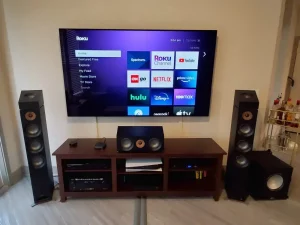 In fact, modern technology and the increasingly inviting and interesting offer of major streaming platforms greatly excite the desires of fans of the genre or simply of those who are not satisfied with the speakers integrated into their TV to watch audio and video multimedia content and want a real home theater able to satisfy your needs.
In fact, modern technology and the increasingly inviting and interesting offer of major streaming platforms greatly excite the desires of fans of the genre or simply of those who are not satisfied with the speakers integrated into their TV to watch audio and video multimedia content and want a real home theater able to satisfy your needs.
Fortunately today, compared to a few years ago, such a system no longer represents a product suitable for spacious environments and, above all, that few can afford because of its cost, because modern technology and increasingly high interest of various companies ready to market their personal products have made the Home Theater Speakers that can satisfy different needs, both in terms of the economic aspect and the level of performance it can guarantee.
So, if you are considering the idea of buying Home Theater Speakers before letting yourself be fascinated by any system, it is good to know how it works and what are the main characteristics that distinguish a good product from another of mediocre quality
In any hHome Theater Speakers , the first thing that should not be missing is a set of speakers located in the main plane of the screen (in many commercial movie theaters are placed behind an acoustically transparent screen) that we call a frontal trio.
It consists of two main front speakers (right and left) plus a center speaker located at the midpoint of the front plane.
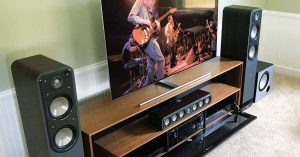 What it is and what it is for
What it is and what it is for
As the word itself says, a home theater system includes several electronic devices that, together, are able to reproduce the entire human acoustic spectrum in a very realistic way in such a way as to offer the sensation of being really inside a cinema or theater. a theater.
Much more simply, Home Theater Speakers installed in your living room allows you to live a totally immersive experience when you watch any type of content on TV to the point of feeling so involved that you have the feeling of being at the center of the scene.
It is a kind of sound realism which, thanks to the correct positioning of the speakers, exploits a sound distribution system that envelops the viewer not only from the front, but also from the back and sides.
Also Read: Best Cheapest 4K Projectors
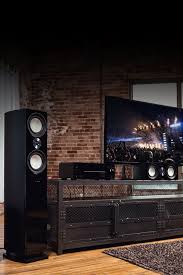 How the home theater system works
How the home theater system works
As already mentioned, a home theater system is made up of several electronic devices of variable number which, connected “in chain”, are able to distribute the sound evenly inside the room and with a high quality and free of any kind of distortion.
Once the various devices have been installed and chained, the home theater must be set using the controls on a console that allow you to equalize the various sounds and which, in the latest generation models, are also present behind each speaker to be even more precise in the setting.
If the home theater is connected to an audio / video source such as, for example, a television, the integrated speakers are excluded and the external ones are privileged, but it can also be connected to a DVD or Blu-ray player , a hi-fi system or a pc.
Instead, the audio speakers can be center, side and rear speakers, one or more subwoofers and surround speakers , while the video outputs can be represented by a television, any type of screen or a projector.
The heart of the home theater system consists of the amplifier which serves to convert the audio signal and distribute it to the different speakers so as to make even a not perfectly symmetrical environment suitable for a uniform and full listening.
It is important that the various components are of the same quality and that they work perfectly chained to each other in order to create the optimal audio / video quality.
Main Front Speakers: Function in our Home Cinema
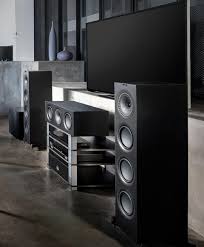 Located on the left and right of the screen and pointing to the listening center, these speakers are the heirs of conventional stereo HiFi systems. Your mission in our home theater system will be double. On the one hand, they will be in charge of reproducing the music we have in formats such as CDs in stereo mode, since the receiver or A / V processor will take them as the main speakers of the equipment and send them these signals.
Located on the left and right of the screen and pointing to the listening center, these speakers are the heirs of conventional stereo HiFi systems. Your mission in our home theater system will be double. On the one hand, they will be in charge of reproducing the music we have in formats such as CDs in stereo mode, since the receiver or A / V processor will take them as the main speakers of the equipment and send them these signals.
In addition, when we use them for cinema, these speakers will generate the most of the fundamental sound scene, reproducing the soundtrack of the film and a large part of the special effects, both considered and main (shots, explosions, blows, etc.) as environmental noises that position us in the action.
Your role is, therefore, paramount. They are the most important in our team and therefore we must pay the most attention and devote a large part of the budget.
Also Read: Best Wireless Soundbars Under 150
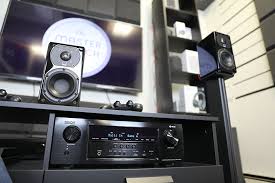 Types of home theater
Types of home theater
There are simpler and more complex types of home theaters, with different configurations and different performances, and knowing how to read the characteristics of the kit is very important to understand what to look for and what you are about to buy.
The basic configuration of a traditional home cinema, which was the standard of surround sound until a few years ago and which allows you to obtain a true surround effect (and not trivially a higher volume), is the 5.1 home theater system. audio system with 5 channels (4 speakers and a subwoofer).
The number of channels is important because the more channels you have, the more speakers you can add to improve the audio quality that increases as the number of speakers increases.
What are home theater channels?
In the technical specifications or next to the model you will always find a number which can be, for example, 5.1 channels, 7.1 channels, 5.1.2 channels and so on.
The home theater channels indicate the number of speakers it supports i.e. the number of speakers and subwoofers that you can connect to your audio system.
But how do you read this information?
The first number on the left indicates the number of speakers, the number after the dot is relative to the subwoofer and if there is a second dot followed by a number it means there is the possibility to configure the Dolby Atmos system ( here a ‘ interesting guide about it ) which involves the installation of two or more speakers on the ceiling.
Also Read: Best Bookshelf Speakers Under $1000
5.1 home theater, 5.1.2 home theater and 7.1 home theater (Dolby Surround, Dolby Atmos, etc.)
If the home theater is 5.1 it means that it has 5.1 channels i.e. 5 speakers in total divided as follows:
- 5 speakers: one center speaker, one left and one right speaker, one rear left and one right speaker;
- 1 subwoofer.
If the home theater is 5.1.2 it means that it supports Dolby Atmos and has 5.1.2 channels i.e. 7 speakers in total divided as follows:
- 5 speakers: one center speaker, one left and one right speaker, one rear left and one right speaker;
- 1 subwoofer;
- 2 speakers on the ceiling.
If the home theater is 7.1 it means it has 7.1 channels i.e. 7 speakers in total divided as follows:
- 5 speakers: one center speaker, one left and one right speaker, one rear left and one right speaker; one left and one right side speaker;
- 1 subwoofer.
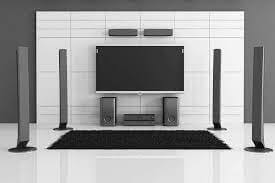 Wireless home theater: is it worth it ?.
Wireless home theater: is it worth it ?.
Purists do not compromise and argue that the best way to transmit sound is the more traditional one through cables. There are, however, wireless home theater surround systems with excellent performance but today they are very expensive .
So, in order not to give up a dolby surround system even if you are on a tight budget, we advise you to opt for a wired home theater with cables and not to make the mistake of choosing a cheap wireless home theater that almost certainly sounds bad, create electromagnetic interference and does not diffuse clean sound.
Also Read: Best Stereo Amplifier Under $1000
The components of the home theater
Now let’s see in detail the characteristics of the home theater components: amplifier, speakers, soundbar and subwoofer.
Home cinema system amplifier
The amplifier is the heart of the home theater system, it allows you to decode the digital audio from the DVD player into dolby digital and DTS and generally receives the audio signal and distributes it to different speakers.
In addition, it powers all speakers then speakers and subwoofers
Home theater speakers
There are various types of speakers in an audio system:
- The central speaker , that is, the person responsible for the voices of the dialogue;
- The two front speakers , left and right, which recreate the environment and the music;
- The surround speakers (always left and right, side and / or rear) can provide dynamic sound and transmit it in the surrounding space.
In addition, based on the sound effect you want to achieve, the space you have available, your personal preferences and furniture, you can choose compact speakers, floor, ceiling or column or even wireless speakers ,
Best home theater 2.1: is the soundbar a good solution?
If you don’t have a lot of space available for your audio system or you don’t want to alter your furniture, wires and speakers, you can opt for a soundbar , i.e. a compact device that incorporates in a single speaker the left, right and center speakers and that gives you a clean and easy to install 3.0 solution.\
Today there are hybrid devices equipped with sound bars and satellite speakers as well as modular solutions that, depending on the budget and the size of the room, you can always expand later to improve the performance of your home theater system by adding new surround speakers.
Also Read: Best Electric Skateboard Under $500
Towers or Shelving Monitors?
These power and frequency requirements lead us to the conclusion that the column loudspeakers, whenever we can install them in our room, are usually the best candidates to form our main left and right channel pairings.
Most manufacturers opt for two design modes (we will talk about this in more depth in a dedicated article): Or many relatively small drivers to give higher sound pressure (for example two, three or four 6.5 inches) in the low frequencies, either one or two but larger (8 or 10 inches). Which is better?
Again, it depends on the specific model and design, but generally the greater the driver for bass, the better the response will be at a low frequency and with less distortion since the maximum excursion of the membrane will not exceed the linear operating range.
My personal opinion is that if you can choose between for example a speaker with two or three drivers of 6 inches and another with two of 8 or one of 10 , you go for the latter (at equal prices and conditions and after listening to all of them , since we should never buy a box without having previously heard it).
So, do bookshelf speakers not serve as front channels? Of course, they serve, there are very valid models. The only problem they have is that, in general, they will not support as much power as the column ones, since they incorporate smaller drivers (normally they are 6 inches, although there are also up to 8 inches) and in less quantity (usually, one although there are models with more).
The boxes or monitors of shelving will be our option if we do not have space in the room to place some good columns or if our budget does not arrive for it. (Equal budget is better to buy two good bookshelf monitors than two columns of poor quality).
Of course, they must meet the aforementioned requirements of having drivers of at least 6 inches and for my taste a frequency response a little more relaxed, down to about 50 or 60 Hz. The rest of the bass frequencies will be sent to the subwoofer, as we will see in the corresponding article.
Also Read: How Many Lumens Do I Need For a Projector
The central channel: Is it really necessary to have a center speaker?
The mission of the central channel in cinema systems 5.1 or higher is to reproduce the main dialogues of the film so that they are always clear and localized in spite of the rest of the music and effects of the soundtrack.
Initially, the cinemas reproduced the dialogues by the main front left and right speakers, with very different results depending on the position of the listener, hence the incorporation of a central channel that would allow the best location of the sound in the center of the screen.
Some people say that the home speaker can be completely dispensed with in the home theater, as long as the front speakers offer a good sound image. This is true, but only half. If we are going to listen to a movie in a room, we are alone and we are at the “sweet” listening point (in the center of the signal coming from all the speakers) probably the sound image will be adequate and we will not notice any problems.
But if as usual, we are several listeners each in a position that can be very different with respect to this ideal listening point, we can lose spatial precision and give the feeling that the voices come from the left or the right and not from the center of the screen.
Hence, it is advisable in most cases to have a center speaker that will be responsible for centering, locating dialogues and other main sound effects of the film.
Home theater: prices
The price of home theaters varies both according to the performance and quality of the model and according to the prestige of the brand.
In any case, to buy the basic configuration to obtain a surround effect, that is a 5.1 sound system, the starting price is about 300 dollars even if thanks to the online offers you can get cheaper prices.
Mid-range brands such as Sony and Yamaha have solutions on sale even for 700 dollars while if you have the availability of spending you can even spend 3000 dollars (or much more for premium equipment) to set up your home cinema! Everything depends on you.
Also Read: Best Radar Detector Under $200
Home Theater Speakers | Video Explanation
FAQs
How much space do you have available?
Think about the arrangement of the furniture in the room and the size of the same, always taking into account that a home theater system takes up space and that the speakers cannot be arranged randomly if you want to get a dolby surround effect .
Fortunately, there are several solutions to overcome this problem and in the most extreme case you can opt for a soundbar.
How big is the room where you will place your home theater?
You should choose a system with a number of speakers compatible with the size of the room. For example, many users are happy with a 5.1 home theater system placed in the living area of about 20 square meters.
What devices do you connect?
Do you like streaming TV series or do you prefer DVD or BlueRay movies? Do you have a Smart TV or do you use your PC to connect to the network? Do you love football and do you have digital terrestrial or a subscription? We could give you many other examples but, in any case, you need to check the number of inputs available and their compatibility with your channels.
How much does a home theater cost?
The cost of a home theater varies according to the model, features and brand. Prices range from € 100 for the cheapest models to € 600 for the top-of-the-range models. To find out the best prices online read: ranking and prices .
CONCLUSION
By Home Theater Speakers we mean the reproduction of television or cinematographic contents in a domestic environment with auditory and visual sensations as close as possible to those that can be had in a theater or cinema We hope after reading this you may get your desierd product.
